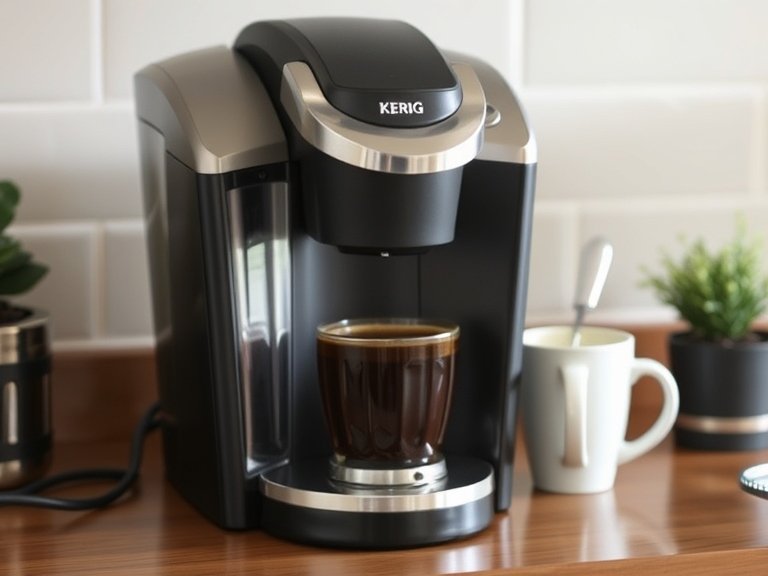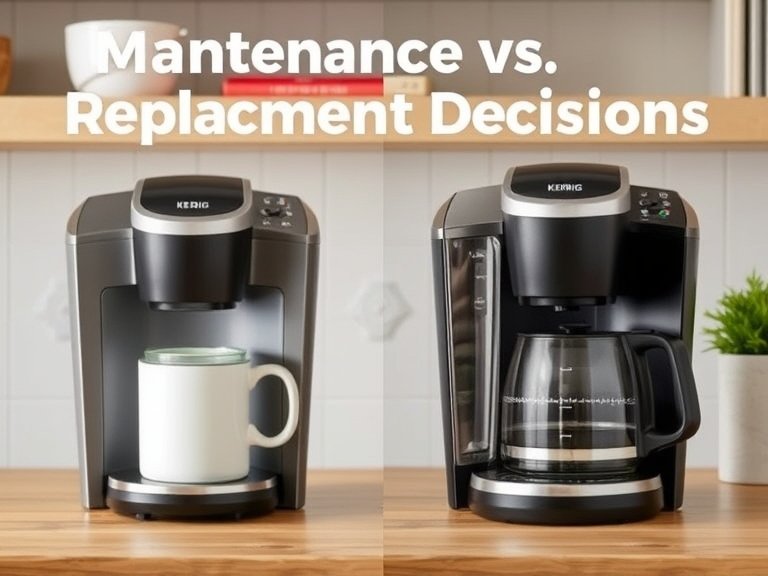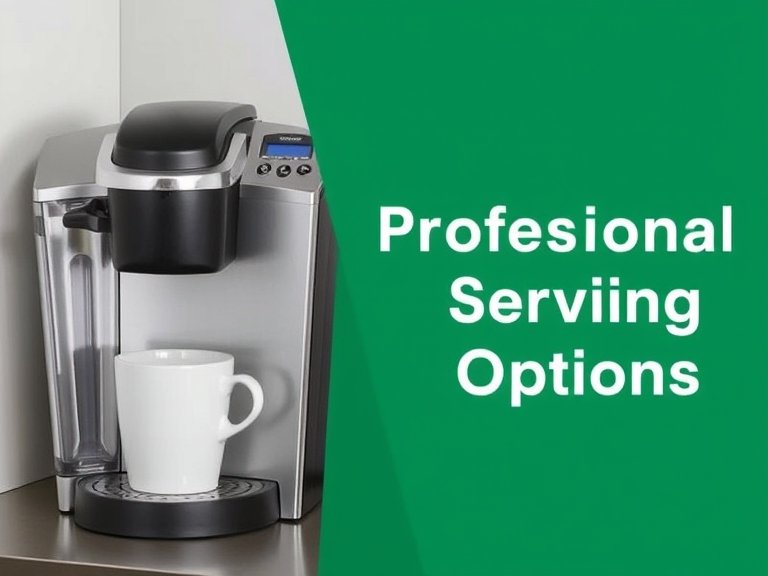Understanding Keurig Coffee Maker Longevity
A Keurig coffee maker typically lasts between 3-5 years with proper care and maintenance. However, many users report their machines functioning well beyond this timeframe when following recommended maintenance procedures.
Also Read: Maximize Keurig Lifespan: How Long Do They Last?
The actual lifespan depends heavily on usage patterns, water quality, and regular cleaning routines.
Factors Affecting Your Keurig’s Lifespan
Water quality plays a crucial role in determining how long your Keurig will last. Hard water containing high mineral content can lead to faster buildup of calcium deposits, potentially shortening your machine’s life.
Using filtered water can significantly reduce this issue and extend your brewer’s functionality.
Daily usage patterns impact longevity considerably. A Keurig used multiple times daily in a busy office environment might wear out faster than one used occasionally in a home setting.
The machine’s internal components face more stress with frequent use, potentially leading to earlier replacement needs.
Essential Maintenance for Extended Lifespan
Regular descaling is paramount for maintaining your Keurig’s performance. This process removes mineral deposits that accumulate over time and can clog the internal components.
Experts recommend descaling every 3-6 months, depending on usage and water hardness.
Cleaning the external components regularly helps prevent coffee grounds and oils from building up. Wipe down the exterior, clean the drip tray, and wash the water reservoir weekly.
These simple steps can prevent bacterial growth and ensure consistent coffee flavor.
Signs Your Keurig Needs Replacement

When your Keurig starts brewing slower than usual or produces less hot coffee, it might be showing signs of age.
Strange noises during operation, inconsistent water flow, or frequent pump malfunctions are also indicators that replacement might be necessary.
If your machine requires multiple brewing attempts to produce a single cup, this could indicate internal wear and tear.
While some issues can be resolved through maintenance, persistent problems might signal the end of your Keurig’s useful life.
Optimal Usage Practices for Longevity
- Clean after each use
- Wipe down the K-cup holder
- Empty and rinse the drip tray
- Remove used pods immediately
- Regular maintenance schedule
- Weekly cleaning of removable parts
- Monthly deep cleaning
- Quarterly descaling treatments
Water Quality and Its Impact
Using high-quality water significantly affects your Keurig’s performance and lifespan. Consider installing a water filter or using filtered water to reduce mineral buildup.
This simple step can extend your machine’s life by years and improve coffee taste.
The water temperature during brewing should remain consistent. If you notice temperature fluctuations, it might indicate scaling issues or potential heating element problems that require attention.
Common Issues and Solutions
Pump problems often occur due to air bubbles or mineral buildup. Running several water-only cycles can help clear these issues. If problems persist, descaling might be necessary to restore proper function.
Leaking machines typically indicate worn seals or gaskets. While some components can be replaced, extensive leaking in older units might suggest it’s time for a new machine.
The Impact of Usage Patterns
Heavy users should implement more frequent maintenance schedules. Office environments might need weekly descaling and daily cleaning routines.
Home users with moderate consumption can maintain longer intervals between deep cleaning sessions.
Consider the cost-effectiveness of repairs versus replacement. After 3-5 years, significant repairs might not be economically justified compared to purchasing a new unit with updated features.
Maintenance vs. Replacement Decisions

When facing repeated issues, evaluate the cost of repairs against new machine prices. Modern Keurig models offer improved energy efficiency and additional features that might justify an upgrade from an older, problematic unit.
Calculate the annual maintenance costs against the price of a new machine. Sometimes, investing in a new unit proves more economical than continuing to repair an aging system.
Environmental Considerations
Proper maintenance not only extends your Keurig’s life but also reduces environmental impact. A well-maintained machine uses less energy and produces better-tasting coffee, reducing waste from unsatisfactory brews.
Consider using reusable K-cups to reduce environmental impact and potentially extend the life of your machine by reducing wear on the puncture mechanism.
Technology Advancements and Upgrades
Newer Keurig models incorporate improved brewing technology and better energy efficiency. While older machines can provide years of service, new features might offer compelling reasons to upgrade even a functioning unit.
Modern units often include enhanced descaling reminders and maintenance alerts, helping users maintain optimal performance through timely care.
Storage and Protection
Proper storage during periods of non-use can extend your Keurig’s life. Empty the water reservoir, run a cleaning cycle, and store it in a clean, dry place if the machine won’t be used for extended periods.
Use a surge protector to protect your machine from power surges. Electrical issues can damage internal components and shorten their lifespan.
Professional Servicing Options

While many maintenance tasks can be performed at home, professional servicing might be beneficial for complex issues. Some authorized service centers can extend your Keurig’s life through expert repairs and parts replacement.
Consider annual professional cleaning services for office machines or heavily used units to ensure optimal performance and longevity.
Editor’s Recommendations
- Use filtered water for brewing
- Perform regular maintenance on schedule
- Clean removable parts weekly
- Descale according to usage patterns
- Consider professional servicing annually
Frequently Asked Questions
How often should I describe my Keurig?
Descale every 3-6 months, or more frequently with hard water and heavy use.
Why is my Keurig brewing slower than usual?
Slow brewing usually indicates mineral buildup requiring descaling or possible pump issues.
Can I use vinegar to clean my Keurig?
While possible, manufacturer-approved descaling solutions are recommended for optimal results and warranty compliance.
How do I know if my Keurig needs replacement?
Consider replacement if you experience persistent problems after descaling, significant leaking, or inconsistent brewing temperatures.
What’s the best way to prevent calcium buildup?
Use filtered water and maintain regular descaling schedules to prevent calcium accumulation.
Conclusion
A Keurig coffee maker’s lifespan depends on maintenance practices and usage patterns. With proper care, including regular descaling, cleaning, and using quality water, most units can provide reliable service for 3-5 years or more.
Also Read: Maximize Keurig Lifespan: How Long Do They Last?
Understanding the signs of wear and implementing preventive maintenance can significantly extend your machine’s useful life.
While eventual replacement is inevitable, following these guidelines helps ensure you get the maximum value and performance from your investment.
Remember that upgrading to newer models might provide better features and energy efficiency, making replacement worth considering even for functioning older units.

